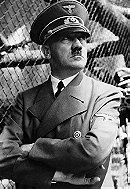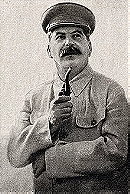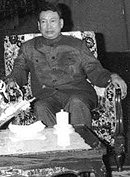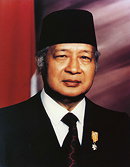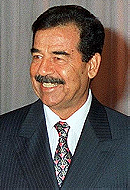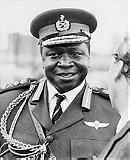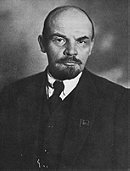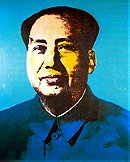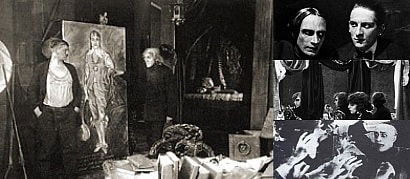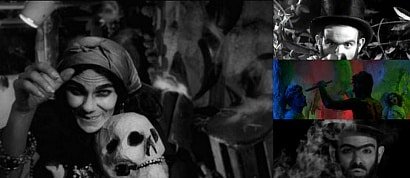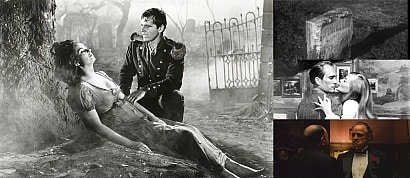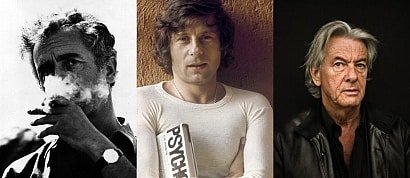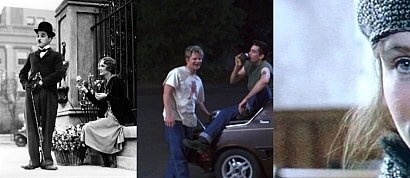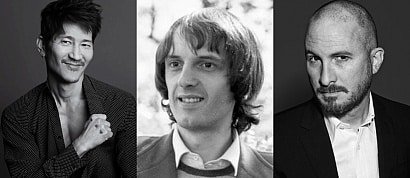Democidal Leaders
Sort by:
Showing 9 items
Rating:
List Type:

Picture of Che Guevara
Ernesto "Che" Guevara was a reckless bourgeois adrenaline-junkie seeking a place in history as a liberator of the oppressed. But this fanatic’s vehicle of “liberation” was Stalinism, named for Soviet dictator Josef Stalin, murderer of well over 20 million of his own people. As one of Castro’s top lieutenants, Che helped steer Cuba’s revolutionary regime in a radically repressive direction. Soon after overthrowing Batista, Guevara choreographed the executions of hundreds of Batista officials without any fair trials. He thought nothing of summarily executing even fellow guerrillas suspected of disloyalty and shot one himself with no due process.
Che was a purist political fanatic who saw everything in stark black and white. Therefore he vociferously opposed freedoms of religion, speech, press, assembly, protest, or any other rights not completely consistent with his North Korean-style communism. How many rock music-loving teens sporting Guevara t-shirts today know their hero supported Cuba’s 1960s’ repression of the genre? How many homosexual fans know he had gays jailed?
How anyone can see this homophobic, murdering, failure as anything but what he truly was indicates lack of morals and decency or just plain foolishiness.
SFC31B442S's rating:



Picture of Adolf Hitler
(20 April 1889 – 30 April 1945) was an Austrian-born German politician and the leader of the National Socialist German Workers Party (German: Nationalsozialistische Deutsche Arbeiterpartei, abbreviated NSDAP), commonly known as the Nazi Party.
One of the foundations of Hitler's social policies was the concept of racial hygiene. It was based on the ideas of Arthur de Gobineau, a French count; eugenics, a pseudo-science that advocated racial purity; and social Darwinism. Applied to human beings, "survival of the fittest" was interpreted as requiring racial purity and killing off "life unworthy of life." The first victims were children with physical and developmental disabilities; those killings occurred in a programme dubbed Action T4. After a public outcry, Hitler made a show of ending this program, but the killings continued.
Between 1939 and 1945, the SS, assisted by collaborationist governments and recruits from occupied countries, systematically killed somewhere between 11 and 14 million people, including about six million Jews in concentration camps, ghettos and mass executions, or through less systematic methods elsewhere. In addition to those gassed to death, many died as a result of starvation and disease while working as slave labourers (sometimes benefiting private German companies). Along with Jews, non-Jewish Poles, Communists and political opponents, members of resistance groups, homosexuals, Roma, the physically handicapped and mentally retarded, Soviet prisoners of war (possibly as many as three million), Jehovah's Witnesses, Adventists, trade unionists, and psychiatric patients were killed. One of the biggest centers of mass-killing was the industrial extermination camp complex of Auschwitz-Birkenau.
SFC31B442S's rating:



Picture of Joseph Stalin
Joseph Vissarionovich Stalin (18 December 1878 – 5 March 1953) was a Soviet politician and head of state who served as the first General Secretary of the Communist Party of the Soviet Union's Central Committee from 1922 until his death in 1953. After the death of Vladimir Lenin in 1924, Stalin rose to become the leader of the Soviet Union, which he ruled as a dictator.
Under the dictatorship of Joseph Stalin, tens of millions of ordinary individuals were executed or imprisoned in labour camps that were little more than death camps. Perceived political orientation was the key variable in these mass atrocities. But gender played an important role, and in many respects the Purge period of Soviet history can be considered the worst gendercide of the twentieth century.
SFC31B442S's rating:



Picture of Pol Pot
Saloth Sar (January 25, 1925 – April 15, 1998), better known as Pol Pot, was the leader of the Cambodian communist movement known as the Khmer Rouge and was Prime Minister of Democratic Kampuchea from 1976–1979. His time as the leader of Cambodia, in which he attempted to "cleanse" the country, resulted in the deaths of an estimated 1.7 to 2.5 million people.
Pol Pot became leader of Cambodia in mid-1975. During his time in power, Pol Pot imposed a version of agrarian socialism, forcing urban dwellers to relocate to the countryside to work in collective farms and forced labor projects, toward a goal of "restarting civilization" in a "Year Zero". The combined effects of forced labour, malnutrition, poor medical care and executions resulted in the deaths of approximately 21% of the Cambodian population.
In 1979, after the invasion of Cambodia by neighboring Vietnam in the Cambodian–Vietnamese War, Pol Pot fled into the jungles of southwest Cambodia and the Khmer Rouge government collapsed. From 1979 to 1997 he and a remnant of the old Khmer Rouge operated from the border region of Cambodia and Thailand, where they clung to power and United Nations recognition as the rightful government of Cambodia.
Pol Pot died in 1998 while held under house arrest by the Ta Mok faction of the Khmer Rouge. Since his death, rumours that he was poisoned have persisted.
SFC31B442S's rating:



Picture of Suharto
AKA 'Pak Harto' (Father Harto), AKA 'The Smiling General', AKA 'Bapak Pembangunan' (Father of Development). Suharto can also be spelt Soeharto. Following a pilgrimage to Mecca in 1991, Suharto took the name Haji Mohammed Suharto. (8 June 1921 – 27 January 2008)
Country: Indonesia.
Kill tally: Up to two million killed following an alleged coup attempt in 1965 (most reports estimate the number at around 500,000). Over 250,000 deaths following the invasion of East Timor in 1975. Thousands more killed in various Indonesian provinces.
Coverage of the fall of Suharto reveals with startling clarity the ideological biases and propaganda role of the mainstream media. In the months of his exit, he was referred to as Indonesia's "soft-spoken, enigmatic president" (USA Today, 5/15/98), a "profoundly spiritual man" (New York Times, 5/17/98), a "reforming autocrat" (New York Times, 5/22/98). His motives were benign: "It was not simply personal ambition that led Mr. Suharto to clamp down so hard for so long; it was a fear, shared by many in this country of 210 million people, of chaos" (New York Times, 6/2/98); he "failed to comprehend the intensity of his people's discontent" (New York Times, 5/21/98); otherwise he undoubtedly would have stepped down earlier. He was sometimes described as "authoritarian," occasionally as a "dictator," but never as a mass murderer. Suharto's mass killings were referred to-if at all-in a brief and antiseptic paragraph.
The good Democidist is also repeatedly allowed credit for having encouraged economic growth, which provides the regular offset for his repression and undemocratic rule as well as mass killing. In virtually every article written on Indonesia, the fact that Suharto brought rising incomes is featured, with the mass killings and other negatives relegated to side issues that qualify the good. Joseph Stalin also presided over a remarkable development and growth process, but the mainstream media have never been inclined to overlook his crimes on that basis. Only constructive terror deserves such contextualization.

Picture of Saddam Hussein
Full name Saddam Hussein al-Majid al-Tikriti. AKA 'Great Uncle', AKA 'Lion of Babylon', AKA 'Lion of Iraq', AKA 'Beast of Baghdad'. Saddam translates to 'One Who Confronts'. (28 April 1937 – 30 December 2006)
Country: Iraq.
Kill tally: Approaching two million, an estimated 1,000 Kuwaiti nationals killed following the Iraqi invasion of Kuwait. No conclusive figures for the number of Iraqis killed during the Gulf War, with estimates varying from as few as 1,500 to as many as 200,000. Over 100,000 Kurds killed or "disappeared". No reliable figures for the number of Iraqi dissidents and Shia Muslims killed during Saddam's reign, though estimates put the figure between 60,000 and 150,000. (Mass graves discovered following the US occupation of Iraq in 2003 suggest that the total combined figure for Kurds, Shias and dissidents killed could be as high as 300,000).
*NOTE: People whine that President Bush invaded Iraq for oil, blah, blah, blah. Before you embarrass yourself and post a comment in the vein, I recommend you study the American government, namely the powers invested in the US President and the US Congress regarding the use of military forces. The 1973 War Powers Resolution is very important to study as well.
Also read United Nations Security Council Resolution 1441 and all previous UN Resolutions including: resolutions 661 (1990), 687 (1991), 699 (1991), 707 (1991), 715 (1991), 986 (1995), 1051 (1996), 1153 (1998), 1175 (1998), 1242 (1999) and 1266 (1999), and 1284 (1999). All of which were ignored by the Iraqi government. These resolutions were adopted under Chapter VII of the U.N. Charter which allows the "use of force for the express purpose of restoring international peace and security".

Picture of Idi Amin
Idi Amin Dada (c.1925 – 16 August 2003) was a military leader and President of Uganda from 1971 to 1979. Amin joined the British colonial regiment, the King's African Rifles, in 1946, and eventually held the rank of Major General and Commander of the Ugandan Army prior to taking power in the military coup of January 1971, deposing Milton Obote. He later promoted himself to Field Marshal while he was the head of state.
Amin's rule was characterised by human rights abuses, political repression, ethnic persecution, extrajudicial killings, nepotism, corruption and gross economic mismanagement. The number of people killed as a result of his regime is estimated by international observers and human rights groups to range from 100,000 to 500,000.

Picture of V.I. Lenin
Vladimir Lenin (April 10, 1870 – January 21, 1924) was born Vladimir Ilich Ulianov and assumed the pseudonym of Lenin in 1900.
On October 25, 1917, Lenin seized power from the enfeebled Provisional Government. Lenin shrewdly justified his violent seizure of power as merely a transfer of authority to the soviets, the popular councils elected by workers and soldiers that sprang up everywhere after the fall of the tsar. Lenin declared the formation of a Soviet government, withdrew Russia from World War I, and invited the peasants to take charge of the land that had formerly belonged to the nobles, state, and church. At the same time, Lenin's government quickly moved to shut down opposition political parties and to censor the press, introduced conscription for the Red Army, and requisitioned grain from the peasants in order to fight the bloody Russian Civil War of 1918–1920. In January 1918, Lenin closed down the Constituent Assembly after the Bolsheviks won only 24 percent of the popular vote. In 1918, Lenin renamed the Bolshevik Party as the Communist Party.
In December 1922, Lenin renamed his revolutionary state as the Union of Soviet Socialist Republics. Meanwhile, working-class protestors who demanded greater democracy, such as the Kronstadt mutineers in 1921, were brutally suppressed. The same fate awaited dissident factions within the Bolshevik Party, which were banned at the Tenth Party Congress of 1921.
Lenin ordered the creation of a device to enforce the "iron fist of the dictatorship of the proletariat", or Lenin's whim. The term "dictatorship of the proletariat" was an obscure reference used by Karl Marx in a few of his letters; most historians agree that he meant to use the term as an analogy. Lenin thought it was catchy, so he applied it in all his decrees. He ordered Feliks Dzershinsky to oversee an extraordinary committee to "liquidate any counterrevolutionary activities". This organization eventually became the Cheka, the feared Bolshevik secret police.
The Cheka were highly active during the Russian civil war, from 1918 to 1920. During this period the Cheka carried out massive deportations and executions of any "suspect elements". This included political groups such as the Mensheviks, Social Democrats, anarchists, but it also included many others: striking workers, merchants, peasants resisting the Bolshevik theft of their crops, and the kulaks, a vague term that meant all non-poor peasants but was also a codeword for a Menshevik. Lenin was paranoid; he saw any dissent as proof of a "massive Menshevik conspiracy". Here is a telegram to the head of the Penza soviet on 10 August 1918, following a peasant riot against Red Army conscription:
--------------------------------------------------------
Comrades! The kulak uprising in your five districts must be crushed without pity. The interests of the whole revolution demand such actions, for the final struggle with the kulaks have now begun. You must make an example of these people. (1) Hang (I mean hang publicly, so people can see it) at least 100 kulaks, rich bastards, and known bloodsuckers. (2) Publish their names. (3) Seize all their grain. (4) Single out the hostages per my instruction in yesterday's telegram. Do all this so that for miles around people can see it all, understand it, tremble, and tell themselves that we are killing the bloodthirsty kulaks and that we will continue to do so. Reply saying that you have received and carried out these instructions.
Yours, Lenin.
P.S. Find tougher people.
--------------------------------------------------------
Thus began the Red Terror, Lenin's reign of terror. On September 5 1918 Lenin legalized Cheka terror with a decree titled "On Red Terror". With the Cheka and the Red Army under his command Lenin massacred millions of Russians suspected of "treason" against the Bolshevik dictators. Their methods were brutal. The Red Army would sometimes simply surround a village in a pro-Menshevik area and shoot everyone. Most of the time entire families with suspect backgrounds would be sent to concentration camps in Eastern Russia. In areas with Menshevik partisans, the Cheka would gather hostages from families and execute them in an effort to draw out the rebels. People would also be arrested for simply "belonging to an enemy class" or being "socially undesirable", and executed.
The Cossacks living near the Don and the Kuban were farmer-warriors with a strong streak of independence. When they refused to give up their land to the Bolsheviks, Lenin ordered the wholesale massacre of the Cossacks. He justified this genocide, known later as "De-Cossackization", with these words: "In view of the experiences of the civil war against the Cossacks, we must recognize as the only politically correct measure massive terror and a merciless fight against the rich Cossacks, who must be exterminated and physically disposed of, down to the last man." In February 1919 alone the Cheka reported the executions of over 8000 Cossacks and twice as many deportations to the East. The rich farming lands of the Don were emptied to make way for collective farms. Recent estimations guess at between 300000 to 500000 deaths out of a population of no more than 3 million.
Even with the end of the civil war Lenin continued his murderous rampage. The most notable example was the "pacification" of the miners in the Tambov province that revolted against inhumane working hours and the unreasonable rationing of food. Order No. 171, dated 11 June 1921 and signed by Lenin, Dzershinsky and other cheka notables, stipulated:
Shoot on sight any citizens who refuse to give their names.
District and Regional Political Commissions are hereby authorized to pronounce sentence on any village where arms are being hidden, and to arrest hostages and shoot them if the whereabouts of the arms are not revealed.
Wherever arms are found, execute immediately the eldest son of the family.
Any family that has harbored a bandit is to be arrested and deported from the province, their possessions are to be seized, and the eldest son is to be immediately executed.
Any families sheltering other families who have harbored bandits are to be punished in the same manner, and their eldest son is to be shot.
In the event that bandit families have fled, their possessions are to be redistributed among peasants who are loyal to the Soviet regime, and their houses are to be burned or demolished.
These orders are to be carried out rigorously and without mercy.

Picture of Mao Tsé-tung
AKA Chairman Mao, AKA 'The Great Helmsman'. (Tse-Tung can also be spelt Zedong. In translation the name means 'To Shine on the East'.)
(December 26, 1893 – September 9, 1976), was a Chinese Communist revolutionary, guerilla warfare strategist, poet, political philosopher, and leader of the Chinese Revolution. He was the architect and founding father of the People's Republic of China (PRC) from its establishment in 1949, and held authoritarian control over the nation until his death in 1976. His theoretical contribution to Marxism-Leninism, along with his military strategies and brand of policies, are collectively known as Maoism.
Chairman Mao “cast himself as a revolutionary leader but whose conduct and attitudes reminded one of China’s emperors.” Through disastrous economic policies and periodic purges of his political enemies, Mao was responsible for the unnecessary deaths of millions of Chinese citizens.
To shore up his power base of poor peasants, Mao targeted wealthy capitalists as enemies. In 1951, the Chinese government trained tens of thousands of workers to spy upon their fellow citizens. Workers informed on bosses, wives on husbands, and children on parents, mostly in an attempt to protect themselves from government reprisals. The media joined in on the attack, making accusations. Many people were arrested, a few killed, most fined, and some imprisoned. All were terrified and humiliated. There were at least 200 to 300,000 suicides. So many people jumped to their deaths from Shanghai skyscrapers that they got the nickname “parachutes.”
Then, in January 1958, Mao Zedong launched his economic growth plan, “The Great Leap Forward.” Farm workers were organized into people’s communes. All private food production was banned. Livestock and farm implements became property of the commune.
Mao then ordered the implementation of new agricultural techniques – untested and unscientific. The program was ill-managed and corrupt. Food production began to decline. Then, compounded by drought in some areas and floods in others, the production of wheat dropped dangerously low. The result: a food shortage so severe that millions of peasants starved to death. Mao acknowledged the deaths by occasionally abstaining from eating meat.
Mao remains a controversial figure to this day, with a contentious legacy that is subject to continuing revision and fierce debate. Nationwide political campaigns led by Mao, such as the Great Leap Forward and the Cultural Revolution were catastrophic failures and caused millions of deaths, famine, religious persecution, and damage to the culture, society and economy of China. His rule from 1949 to 1976 is believed to have caused the deaths of 40 to 70 million people.
Democide is a term revived and redefined by the political scientist Rudolph Rummel for "the murder of any person or people by a government, including genocide, politicide, and mass murder". He has further stated: "I use the civil definition of murder, where someone can be guilty of murder if they are responsible in a reckless and wanton way for the loss of life, as in incarcerating people in camps where they may soon die of malnutrition, unattended disease, and forced labor, or deporting them into wastelands where they may die rapidly from exposure and disease."
Rummel explicitly excludes battle deaths in his definition. Capital punishment, actions taken against armed civilians during mob action or riot, and the deaths of noncombatants killed during attacks on military targets so long as the primary target is military, are not considered democide.
Rummel explicitly excludes battle deaths in his definition. Capital punishment, actions taken against armed civilians during mob action or riot, and the deaths of noncombatants killed during attacks on military targets so long as the primary target is military, are not considered democide.
Added to
People who voted for this also voted for
The filmography of Jean Vigo
The filmography of F.W. Murnau
Feminist Theory
Coffin Joe Films
Films Directed by Francis Ford Coppola
Michel Simon
Favourite Directors
Jonathan Rosenbaum: The Best Films of the 1960's
My list of very favorite books
Favorite Film Characters
Movies for a decade (1930-1939)
Favorite Books of the 21st Century
The filmography of Todd Solondz
Favorite directors
The filmography of Erich von Stroheim
 Login
Login
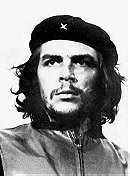
 5
5
 0
0
